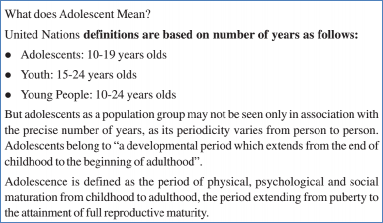6.7. Adolescents

An important aspect of population growth in India is the growth of its adolescents. At present the share of adolescents i.e. up to the age group of 10-19 years is about 21 per cent (2011).. The adolescent population,
though, regarded as the youthful population having high potentials, but at the same time they are quite vulnerable if not guided and channelized properly. There are many challenges for the society as far as these adolescents are concerned, some of which are lower age at marriage, illiteracy – particularly female illiteracy,
school dropouts, low intake of nutrients, high rate of maternal mortality of adolescent mothers, high rates of HIV/AIDS infections, physical and mental disability or retardation, drug abuse and alcoholism, juvenile delinquency and committance of crimes, etc. (Refer Table T5)
In view of these, the Government of India has undertaken certain policies to impart proper education to the adolescent groups so that their talents are better channelized and properly utilized.
The National Population Policy 2000 identifies them as an “under-served population group”, because their needs have not been specifically addressed so far. The Policy describes various strategies to address different needs of adolescents. These are:
(i) provide accurate information about physical, physiological, psychological and social changes and developments that take place during adolescence;
(ii) develop the needed life skills to empower them to avoid risky situations and to attain sound physical, mental and social health;
(iii) provide food supplements and nutritional services; and
(iv) make available the needed health and counseling services available to them.
